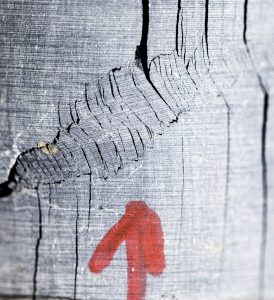
We are working on theoretical and experimental developments in the area of fluid driven fracture propagation in rocks. Our aim is to better quantify the growth dynamics of fluid driven fractures occurring either naturally (magmatic dikes, fractures at glacier beds) or in relation to industrial injection. Our interests span both frictional shear-induced failures of faults as well as the propagation of ‘fresh’ tensile fractures (hydraulic fractures) and their associated seismicity.
- Laboratory experiments
We have developed a unique experimental set-up to perform laboratory experiments on cubic rock samples of 250mm*250mm*250mm size. The cubic blocks can be subjected to a true tria-axial state of stress (up to 20MPa) as well as pore-pressure. Fractures are driven by the injection of a fluid at a constant rate from a wellbore drilled in the specimen. 64 piezo-electric sensors are used to image the fracture growth via active acoustic waves (akin to performing a 4D ‘seismic-like’ imaging at the lab-scale in the ultrasonic range). 16 additional piezo-electric (broadband) sensors record passively acoustic emissions occurring during the failure process.
- Theoretical developments
We have been recently working on frictional ruptures induced by fluid pressurization – developing theoretical understand (scaling laws) and semi-analytical solutions.
In the field of hydraulic fracturing, over the years, we have worked on planar 3D fracture growth in transverse isotropic materials, the effect of buoyancy (in the context of magmatic dykes), heterogeneities of in-situ stress, fracture energy, the impact of complex non-Newtonian rheology (shear-thinning properties etc.) on HF propagation etc.
We have clarified the effect of turbulent flow on hydraulic fracture propagation, especially the effect of friction reducers added to the fracturing fluid during industrial stimulation of shale-gas wells.
- Numerical developments
We are developing a series of open-source codes for the modeling of fracture propagation driven by coupled processes (fluid, solid loadings etc.) in both 2 and 3D. Notably, we have recently released a python-based solver PyFrac for the simulation of planar 3D hydraulic fractures. A similar effort is on-going for simulating the frictional ruptures of fractured rock masses induced by fluid-injection.
We are actively pushing the proper verification of numerical codes, which is critical for such highly non-linear moving boundaries problems.